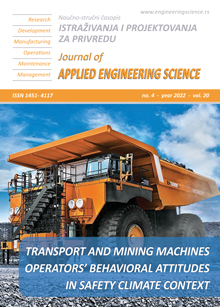AN EMPIRICAL MODEL FOR FORECASTING ELECTRIC GENERATION FOR NEARSHORE ENERGY POTENTIAL IN THAILAND
Abstract
This paper presents electrical energy forecasting from near shore wave potential in the Gulf of Thailand using an empirical model. An electric generator was installed on the near shore to perform measurements and create an empirical model for predicting electric generation. In order to forecast the capacity of the electric generation from sea waves with sufficient electricity consumption, the household data in the Gulf of Thailand and the Andaman Sea were collected from the year 2012 – 2019 to forecast the increasing rate of the number of households in the five years period (2021-2025). Cost and payback period were analyzed in each location in order to invest the renewable energy generation.
References
Thailand Power Development Plan 2015-2036:PDP2015, The ministry of energy of the kingdom of Thailand. https://www.egat.co.th/en/images/about-Egat/PDP2015_Eng.pdf>
Pithayamaythakul, P., &Sojisuporn P. (2016) Water Stratification under Wave Influence in the Gulf of Thailand," Bulletin of Earth Sciences of Thailand, Vol. 7(No. 1): 33-41. http://www.geo.sc.chula.ac.th /BEST/ volume7/number1/BEST_7_1_004_pongdanai.pdf
Foyhirun, C.; Kositgittiwong, D.; Ekkawatpanit, C. (2020) Wave Energy Potential and Simulation on the Andaman Sea Coast of Thailand. Sustainability 2020, 12, 3657, May, 2020, https://doi.org/10.3390/su 12093657
Nizamani, Z., Na, L. L., Nakayama, A., Ali, M. O. A. &Nizamani, M. A. (2021) Renewable Wave Energy Potential for the Sustainable Offshore Oil Platforms in South China Sea, IEEE Access, vol. 9, :116973-116993, 2021, https://doi.org/10.1109/ACCESS.2021.3104729
Song, R.; Zhang, M.; Qian, X.; Wang, X.; Dai, Y.M.; Chen, J. A. (2016) Floating Ocean Energy Conversion Device and Numerical Study on Buoy Shape and Performance. Journal of Marine Science and Engineering, 2016 4, 35:1-14. https://doi.org/10.3390/jmse4020035
Ariyarathne, K. &Jayarathne, P. (2022) Preliminary Assessment of Wave Energy in Srilanka. Proceeding of virtual Conference on Coastal Engineering, 2020, no. 36(v):1-5. December,31,2022. https://doi.org/10.9753/icce.v36v.papers.21>
Bekirov, E. A., Voskresenskaya, S. N., Asanov, M. M. &Murtazaev, E. R.(2020). Analysis of the Sea Waves Energy Characteristics in the Black Sea Region. International Multi-Conference on Industrial Engineering and Modern Technologies (FarEastCon):1-4. https://doi.org/ 10.1109/FarEastCon50210.2020.9271464.
Alkhayyat, M., Brahimi, T., Langodan, S., & Hoteit, I. (2020). Wave Energy in the Red Sea Region Perspectives and Analysis. 6th IEEE International Energy Conference (ENERGYCon), 28 September - 01 October 2020:457-463, doi: 10.1109/ENERGYCon48941.2020.9236479.
Nezhad, M.M., Heydari, A., Neshat,M., Keynia, Piras ,G., & Garcia, D.A. A Mediterranean Sea Offshore Wind classification using MERRA-2 andmachine learning models. Renewable Energy, vol.190 (2022);156-166 https://doi.org/10.1016/j.renene.2022.03.110>
Neshat, M., Sergiienko, N. Y., Mirjalili, S., Nezhad, M.M., Piras, & Garcia, D.A. Multi-Mode Wave Energy Converter Design OptimisationUsing an Improved Moth Flame Optimisation Algorithm. Energies, 2021, 14, 3737. https://doi.org/10.3390/en14133737>
Amini, E., Asadi, R.,Golbaz, D., Nasiri, M.,Naeeni, S.T.O.,MajidiNezhad, M.,Piras, & G.,Neshat,M. Comparative Study of Oscillating Surge Wave Energy Converter Performance: A Case Study for Southern Coasts of the Caspian Sea. Sustainability 2021, 13, 10932. https://doi.org/10.3390/su13- 910932
Mishra, S.K., Mohanta, D.K., Appasani,B., Kabalcı, E. (2021). OWC-Based Ocean Wave Energy Plants Modeling and Control. Springer Nature Singapore Pte Ltd. 2021. https://link.springer.com/book/10.1007/978-981-15-9849-4>
Silva, D., Rusu, E. &Soares, C. G. (2013). Evaluation of Various Technologies for Wave Energy Conversion in the Portuguese Nearshore. Energies 2013, 6(3):1344-1364. https://doi.org/10.3390/en6031344
Cappelli, L., Marignetti, F., Mattiazzo, G., Giorcelli, E., Bracco, G., Carbone, S., &Attaianese, C. (2014) Linear Tubular Permanent-Magnet Generators for the Inertial Sea Wave Energy Converter. IEEE Transaction on Industry Applications, vol.50 (no.3):1817-1828, May/June 2014. https://doi.org/1 0.1109/TIA.2013.2291939
Huang, L., Hu, M., Chen, Z., Yu, H.& Liu, C. (2017) Research on a Direct-Drive Wave Energy Converter Using an Outer-PM Linear Tubular Generator. IEEE Transaction on Magnetics, vol. 53 (no.6), June 2017 https://doi.org/10.1109/TMAG.2017.2664076>
Prudell, J., Stoddard, M., Amon, E., Brekken, A., &Jouanne, A. (2010) A Permanent-Magnet Tubular Linear Generator for Ocean Wave Energy Conversion. IEEE Transactions on Industry Applications vol.46. (No.6):2392-2400, November/December2010. https://doi.org/10.1109/TIA.2010.2073433>
Wahyudie, A., Susilo, T.B. Jehangir, & Nikolaos, S.S. (2018) Design of A 100 W Mini Permanent Magnet Linear Generator for Wave Energy Converter System. 2018 5th International Conference on Renewable Energy: Generation and Applications (ICREGA), 25-28 February 2018 https://doi.org/201810.1109/ICREGA.2018.8337630>
Siddorn, P., & Taylor, R.E. (2008). Diffraction and independent radiation by an array of floating cylinders. Ocean Engineering, vol.35 (Issue 13):1289-1303.September 2008, https://doi.org/10.1016/j.oceaneng.2008.06.003>
Song, R., Zhang, M., Qian, X., Wang, X., Dai, Y. M., & Chen, J. (2016) A Floating Ocean Energy Conversion Device and Numerical Study on Buoy Shape and Performance. Journal of Marine Science and Engineering, vol. 4(no. 35):1-14. May 2016. doi:10.3390/jmse4020035
Phaiboon, S. &Tanukitwattana, K. (2016). Fuzzy Model for Predicting Electric Generation from Sea Wave Energy in Thailand. IEEE Regional 10 Conference, Singapore: 2646-2649. 22-25 November 2016. doi: 10.1109/TENCON.2016.7848518
Official statistics registration systems [online]. Available fromhttps://stat.bora.dopa.go.th/stat/statnew/statmonth/statmonth/#/displayData.
Household energy consumption. National Statistic office Thailand, http://www.nso.go.th.>
MajidiNezhad M.M., Groppi, D., Piras, G. (2018). Nearshore Wave Energy Assessment of Iranian Coastlines. Proceedings of the 4th World Congress on New Technologies (no.ICEPR 180), Madrid, Spain August 19 – 21, 2018.doi: 10.11159/icepr18.180
Marine Meteorological Center, Wave forecasting, Available from http://www.marine.tmd.go.th/

